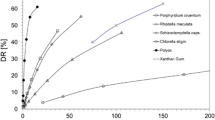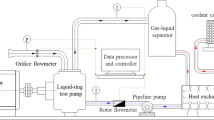Abstract
Anionic polyacrylamide is a hydrolyzed form of polyacrylamide (HPAM), which suffers from mechanical degradation at turbulent flow rates. In order to investigate the possibility of improving the shear resistance of HPAM, various polyacrylamide/polysaccharide mixtures as well as single xanthan gum (XG) and guar gum (GG) polymer solutions were prepared and drag reduction (DR) measurements were performed in a closed flow loop. It was found that the DR efficiencies of both XG and GG solutions were directly proportional to polymer concentration and both solutions exhibited excellent mechanical resistance at turbulent conditions. The presence of XG in concentrated HPAM/XG solutions (C > 450 wppm) significantly improved both DR efficiency and shear resistance of the solutions (6–8% decline after shearing for 2 h). GG solutions exhibited smaller DR efficiencies than XG solutions. Due to small molar mass and low flexibility, GG was not as good a friction reducer as XG and HPAM; therefore, the presence of GG did not improve the DR behavior of the binary solutions. Another issue associated with HPAM is sensitivity to the presence of salt ions in the solution. The effect of salt on the DR behavior was verified by addition of 2% KCl to single and binary solutions. Drag reduction efficiencies of HPAM/XG/KCl solutions were 28 and 20% compared to 10% DR of 1000 wppm HPAM/KCl solution. It was found that the presence of XG in binary solutions significantly reduced the negative effect of salt ions on HPAM molecules.
















Similar content being viewed by others
References
Abdulbari HA, Shabirin A, Abdurrahman H (2014) Bio-polymers for improving liquid flow in pipelines—a review and future work opportunities. J Ind Eng Chem 20:1157–1170
Ames BC, Bunger A (2015) Role of turbulent flow in generating short hydraulic fractures with high net pressure in slickwater treatments. 2015/2/3/
Barati R, Liang J-T (2014) A review of fracturing fluid systems used for hydraulic fracturing of oil and gas wells. J Appl Polym Sci 131:n/a–n/a. doi:10.1002/app.40735
Bello JB, Müller AJ, Sáez AE (1996) Effect of intermolecular cross links on drag reduction by polymer solutions. Polym Bull 36:111–118. doi:10.1007/BF00296015
Berman NS (1978) Drag reduction by polymers. Annu Rev Fluid Mech 10:47–64
Brostow W (1983) Drag reduction and mechanical degradation in polymer solutions in flow. Polymer 24:631–638
Bunger AP, McLennan J, Jeffrey R (2013) Effective and sustainable hydraulic fracturing InTech. Janeza Trdine 9:51000
Den Toonder J, Draad A, Kuiken G, Nieuwstadt F (1995) Degradation effects of dilute polymer solutions on turbulent drag reduction in pipe flows. Appl Sci Res 55:63–82
Dingilian G, Ruckenstein E (1974) Positive and negative deviations from additivity in drag reduction of binary dilute polymer solutions. AIChE J 20:1222–1224
Dschagarowa E, Bochossian T (1978) Drag reduction in polymer mixtures. Rheol Acta 17:426–432
Ghannam MT (1999) Rheological properties of aqueous polyacrylamide/NaCl solutions. J Appl Polym Sci 72:1905–1912
Gittings MR, Cipelletti L, Trappe V, Weitz DA, In M, Lal J (2001) The effect of solvent and ions on the structure and rheological properties of guar solutions. J Phys Chem A 105:9310–9315. doi:10.1021/jp0121825
Habibpour M, Clark PE (2017) Drag reduction behavior of hydrolyzed polyacrylamide/xanthan gum mixed polymer solutions. Pet Sci 1–12. doi:10.1007/s12182-017-0152-7
Jaiswal P, Varacchi B, Ebrahimi P, Dvorkin J, Puckette J (2014) Can seismic velocities predict sweet spots in the Woodford Shale? A case study from McNeff 2–28 Well, Grady County, Oklahoma. J Appl Geophys 104:26–34
Japper-Jaafar A, Escudier M, Poole R (2009) Turbulent pipe flow of a drag-reducing rigid “rod-like” polymer solution. J Non-Newtonian Fluid Mech 161:86–93
Kaufman PB, Penny GS, Paktinat J (2008) Critical evaluation of additives used in shale slickwater fracs. 2008/1/1/
Kenis PR (1971) Turbulent flow friction reduction effectiveness and hydrodynamic degradation of polysaccharides and synthetic polymers. J Appl Polym Sci 15:607–618
Khan MS (2006) Aggregate formation in poly(ethylene oxide) solutions. J Appl Polym Sci 102:2578–2583. doi:10.1002/app.24687
Khan R, Al-nakhli AR (2012) An overview of emerging technologies and innovations for tight gas reservoir development. 2012/1/1/
Kim CA, Choi HJ, Kim CB, Jhon MS (1998) Drag reduction characteristics of polysaccharide xanthan gum. Macromol Rapid Commun 19:419–422. doi:10.1002/(SICI)1521-3927(19980801)19:8<419::AID-MARC419>3.0.CO;2-0
Kim K, Islam MT, Shen X, Sirviente AI, Solomon MJ (2004) Effect of macromolecular polymer structures on drag reduction in a turbulent channel flow. Phys Fluids 16:4150–4162. doi:10.1063/1.1790731
Kulmatova D (2013) Turbulent drag reduction by additives. Phys Rev Lett 84:4765–4768
Larch KL, Aminian K, Ameri S (2012) The impact of multistage fracturing on the production performance of the horizontal wells in shale formations. 2012/1/1
Liberatore MW, Pollauf EJ, McHugh AJ (2003) Shear-induced structure formation in solutions of drag reducing polymers. J Non-Newtonian Fluid Mech 113:193–208
Lim S, Choi H, Lee S, So J, Chan C (2003) λ-DNA induced turbulent drag reduction and its characteristics. Macromolecules 36:5348–5354
Loveless D, Holtsclaw J, Weaver JD, Ogle JW, Saini RK (2014) Multifunctional boronic acid crosslinker for fracturing fluids. 2014/1/19/
Malhotra J, Chaturvedi P, Singh R (1988) Drag reduction by polymer–polymer mixtures. J Appl Polym Sci 36:837–858
Meyer BR, Bazan LW, Jacot RH, Lattibeaudiere MG (2010) Optimization of multiple transverse hydraulic fractures in horizontal wellbores. 2010/1/1
Omrani PS, Delfos R, Boersma B (2012) Polymer induced drag reduction in a turbulent pipe flow subjected to a Coriolis force. Flow Turbul Combust 89:589–599
Paktinat J, Neil BJ, Tulissi MG (2011) Case studies: improved performance of high brine friction reducers in fracturing shale reservoirs. 2011/1/1
Palisch TT, Vincent M, Handren PJ (2010) Slickwater fracturing: food for thought. doi:10.2118/115766-PA
Pereira AS, Andrade RM, Soares EJ (2013) Drag reduction induced by flexible and rigid molecules in a turbulent flow into a rotating cylindrical double gap device: comparison between poly (ethylene oxide), polyacrylamide, and xanthan gum. J Non-Newtonian Fluid Mech 202:72–87. doi:10.1016/j.jnnfm.2013.09.008
Reddy G, Singh R (1985) Drag reduction effectiveness and shear stability of polymer-polymer and polymer-fibre mixtures in recirculatory turbulent flow of water. Rheol Acta 24:296–311
Robinson G, Ross-Murphy SB, Morris ER (1982) Viscosity-molecular weight relationships, intrinsic chain flexibility, and dynamic solution properties of guar galactomannan. Carbohydr Res 107:17–32. doi:10.1016/S0008-6215(00)80772-7
Sandoval GA, Soares EJ (2016) Effect of combined polymers on the loss of efficiency caused by mechanical degradation in drag reducing flows through straight tubes. Rheol Acta 1–11
Shabani B, Kazemzadeh E, Entezari A, Aladaghloo J, Mohammadi S (2014) The calculation of oil-water relative permeability from capillary pressure data in an oil-wet porous media: case study in a dolomite reservoir. Pet Sci Technol 32:38–50. doi:10.1080/10916466.2011.582066
Soares EJ, Sandoval GA, Silveira L, Pereira AS, Trevelin R, Thomaz F (2015) Loss of efficiency of polymeric drag reducers induced by high Reynolds number flows in tubes with imposed pressure. Phys Fluids (1994-present) 27:125105
Sohn J-I, Kim C, Choi H, Jhon M (2001a) Drag-reduction effectiveness of xanthan gum in a rotating disk apparatus. Carbohydr Polym 45:61–68
Sohn JI, Kim CA, Choi HJ, Jhon MS (2001b) Drag-reduction effectiveness of xanthan gum in a rotating disk apparatus. Carbohydr Polym 45:61–68. doi:10.1016/S0144-8617(00)00232-0
Sun H, Wood B, Stevens RF, Cutler J, Qu Q, Lu M (2011) A nondamaging friction reducer for slickwater. Frac Appl. 2011/1/1
Virk PS (1975) Drag reduction fundamentals. AIChE J 21:625–656. doi:10.1002/aic.690210402
White CM, Mungal MG (2008) Mechanics and prediction of turbulent drag reduction with polymer additives. Annu Rev Fluid Mech 40:235–256
Wu Q, Sun Y, Zhang H, Ma Y, Bai B, Wei M (2013) Experimental study of friction reducer flows in microfracture during slickwater fracturing. 2013/4/8
Wyatt NB, Gunther CM, Liberatore MW (2011) Drag reduction effectiveness of dilute and entangled xanthan in turbulent pipe flow. J Non-Newtonian Fluid Mech 166:25–31. doi:10.1016/j.jnnfm.2010.10.002
Zaitoun A, Makakou P, Blin N, Al-Maamari RS, Al-Hashmi A-AR, Abdel Goad M, Al-Sharji HH (2012) Shear stability of EOR polymers. 2011/1/1
Acknowledgments
The authors would like to thank the Research Partnership to Secure Energy for America (RPSEA) and Oklahoma State University Chemical Engineering Department for partial support of this project.
Author information
Authors and Affiliations
Corresponding author
Rights and permissions
About this article
Cite this article
Habibpour, M., Koteeswaran, S. & Clark, P.E. Drag reduction behavior of hydrolyzed polyacrylamide/polysaccharide mixed polymer solutions—effect of solution salinity and polymer concentration. Rheol Acta 56, 683–694 (2017). https://doi.org/10.1007/s00397-017-1024-1
Received:
Revised:
Accepted:
Published:
Issue Date:
DOI: https://doi.org/10.1007/s00397-017-1024-1




